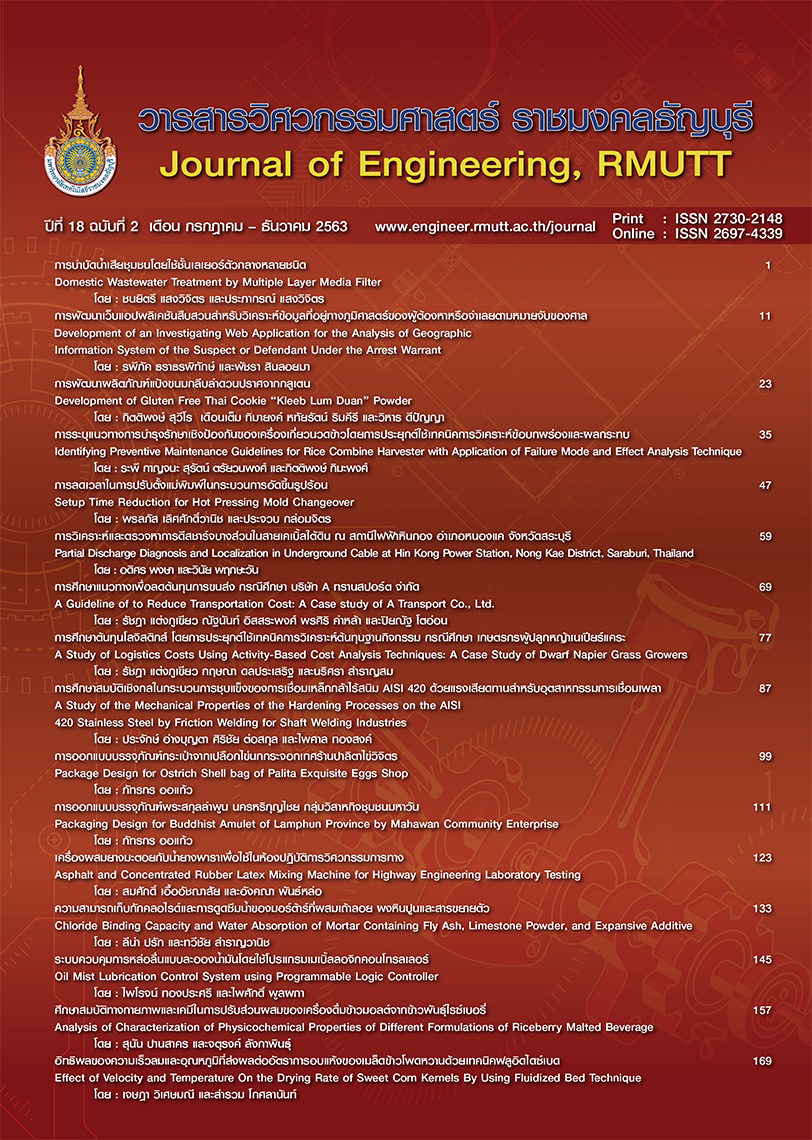การระบุแนวทางการบำรุงรักษาเชิงป้องกันของเครื่องเกี่ยวนวดข้าว โดยการประยุกต์ใช้เทคนิคการวิเคราะห์ข้อบกพร่องและผลกระทบ
##plugins.themes.bootstrap3.article.main##
摘要
การวิจัยนี้มีวัตถุประสงค์เพื่อศึกษาปัจจัยเสี่ยงของเครื่องเกี่ยวนวดข้าวโดยการประยุกต์ใช้เทคนิคการวิเคราะห์ข้อบกพร่องและผลกระทบ (Failure Mode and Effect Analysis: FMEA) ขั้นตอนการดำเนินงานเริ่มต้นจากการแบ่งแยกลักษณะข้อบกพร่องและสาเหตุของการเกิดในการเกี่ยวและนวดข้าว หลังจากนั้นแต่ละประเภทข้อบกพร่องถูกนำมาทำการประเมินและหาค่าลำดับความเสี่ยง (Risk Priority Number: RPN) เพื่อเรียงลำดับจากมากไปหาน้อย ชิ้นส่วนเครื่องจักรที่อยู่ในกลุ่มที่มีค่าระดับความเสี่ยงสูงถูกนำไปวิเคราะห์หาสาเหตุการเกิดข้อบกพร่อง และกำหนดแนวทางการบำรุงรักษาเชิงป้องกัน ผลการวิเคราะห์พบว่ามีอยู่ 5 ประเภทความเสี่ยงจัดอยู่ในกลุ่มความเสี่ยงสูงได้แก่ F21 การสึกหรอบนพื้นผิวของข้อโซ่ F19 การสึกหรอของลูกยางโอริง F14 การสึกหรอบนพื้นผิวของลูกโรลเลอร์ F10 เฟืองสเตอร์สป๊อกเก็ตชำรุด และ F12 ล้อนำชำรุด ซึ่งกลุ่มความเสี่ยงสูงนี้หากเกิดความเสียหายขึ้นจะทำให้เครื่องหยุดทำงาน และส่งผลการปฏิบัติงานในการเกี่ยวนวดข้าวต้องหยุดชะงักเช่นกัน ดังนั้นการจัดทำแนวทางการซ่อมบำรุงเชิงป้องกันจึงจำเป็นอย่างยิ่ง งานวิจัยนี้จึงได้เสนอแนวทางการบำรุงรักษาเชิงป้องกันโดยแนวทางการบำรุงรักษานั้นเกษตรกรผู้ใช้เครื่องเกี่ยวนวดข้าวสามารถดำเนินการได้ด้วยตนเอง ผลของการบำรุงรักษาเชิงป้องกันด้วยตนเองจะให้เป็นการยืดอายุการใช้งานของแต่ละชิ้นส่วนและช่วยให้ประสิทธิภาพในการทำงานของเครื่องเกี่ยวนวดข้าวดีขึ้น
##plugins.themes.bootstrap3.article.details##
The manuscript, information, content, picture and so forth which were published on Frontiers in engineering innovation research has been a copyright of this journal only. There is not allow anyone or any organize to duplicate all content or some document for unethical publication.
参考
Selling a Rice Conbinr Harveter [Internet].Bangkok: Denchai Karnchang 2018 August- [cited 2018 August 14] Available from: http://densakchai.blogspot.com/2013/02/blog-post_2.html
Thai Rice [Internet]. Bankok: Department of Trade Negotiations 2018 August-[cited 2018 August 14] Available from:http://www.thaifta.com
Kaeowongsa S, Phanritdum. The application of FEMA to reduce errors in engineering design of project management.Proceeding of Industrial Engineering Network 2555; 2012 October 17-19;Petchburi, Thailand: 879-85 (In Thai).
Samrit S, Kengpol A, Talabgaew S. Reduction of downtime loss by using reliability theory based preventive maintenance:a case study of the concrete industry.KKU Research Journal.2011;16(2):145-
(In Thai).
Wongjirattikarn S, Ratanakuakangwan S.Improvement of preventive maintenance planning of an automobile shaft manufacturer by FMEA technique. The Journal of KMUTTNB. 2013;23(3):643-53
(In Thai).
Jafari H, Saeidi N, Saffari R. Development of FMEA as effective tool for risks assessment in the iraqi container terminals.World of Sciences Journal. 2013;1: 26-32.
Rakesh R, Jos BC, Mathew G. FMEA analysis for reducing breakdowns of a sub system in the life care product manufacturing industry. Inter. J. of Engineering Science and Innovative Technology. 2013;2: 218-25.
Shafiee M, Dinmohammadi F. An FMEA based risk assessment approach for wind turbine systems: a comparative study of onshore and offshore. Energies. 2014;7:619-42.
Vinodh S, Aravindraj S, Ravi SN,Yogeshwaran N. Fuzzy assessment of FMEA for rotary switches: a case study.The TQM Journal.2012;24:461-75.
Thivel PX, Bultel Y, Delpech F. Risk analysis of a biomass combustion process using MOSAR and FMEA methods. Journal of Hazardous Materials. 2008;151: 221-31.
Huadong Y, Zhigang B. Risk evaluation of boiler tube using FMEA. Proceedings of the 6th International Conference on Fuzzy Systems and Knowledge Discovery; 2009 August 14-16; Tianjin,
China: 81-5.

